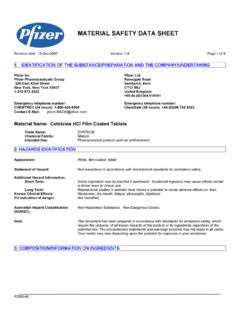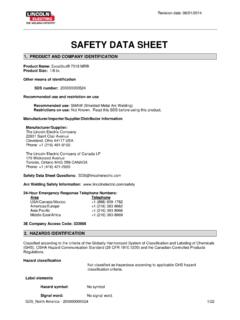Transcription of MATERIAL SAFETY DATA SHEET Universal Color Tint
1 MATERIAL SAFETY data SHEET Universal Color Tint Universal Color Tint Product Name: Universal Color Tint Product Number: Universal Color Tint MSDS #: 02/2011#1. Date Issued: 02/2011. Issued by: Citadel Floor Finishing Systems For Emergency Assistance involving chemicals call CHEMTREC (800) 424-9300. Manufactured by: Citadel Floor Finishing Systems 3001 103rd ln NE. Blaine, MN 55449. 866-765-4310. Manufactured exclusively for Citadel Floor Finishing Systems TRANSPORTATION EMERGENCY CALL CHEMTREC: (800) 424-9300 INTERNATIONAL: (703) 527-3887. 1. Product and Company Identification Product Number: Universal Color Tint Chemical Family: Color Tint 2. Hazards Identification Emergency Overview CAUTION! Reports have associated repeated and prolonged occupational overexposure to solvents with permanent brain and nervous system damage.
2 Intentional misuse by deliberately concentrating and inhaling the contents may be harmful or fatal. Potential Health Effects Primary Routes of Entry: Skin Contact, Eye Contact, Ingestion, Inhalation. Medical Conditions Aggravated by Exposure Causes headache, drowsiness or other effects to the central nervous system. Kidney injury may occur. HUMAN EFFECTS AND SYMPTOMS OF OVEREXPOSURE. Inhalation / Acute Inhalation For Product: Universal Tint Move injured person into fresh air and keep person calm under observation. Get medical attention immediately. For breathing difficulties, oxygen may be necessary. If breathing stops, provide artificial respiration. Skin / Acute Skin For Product: Universal Tint Remove contaminated clothing and shoes.
3 Wash off immediately with plenty of water for at least 15 minutes. Get medical attention, if symptoms develop or persist. Chronic Skin For Product: Universal Tint Prolonged contact can cause reddening, swelling, rash, and in some cases, skin sensitization. Eye / Acute Eye For Product: Universal Tint Get medical attention, if symptoms develop or persist. Immediately flush eye(s) with plenty of water. Remove any contact lenses and open eyes wide apart. Ingestion / Acute Ingestion For Product: Universal Tint Give one or two glasses of water. Only induce vomiting at the instruction of medical personnel. Get medical attention. Medical conditions aggravated by over-exposure May cause or aggravate dermatitis and asthma.
4 Carcinogenicity No Carcinogenic substances as defined by IARC, NTP and/or OSHA. 3. Composition/Information on Ingredients Weight % Components CAS-No. 55 - 60 TITANIUM DIOXIDE 13463-67-7. 10-15 PROPYLENEGLYCOL MONOMETHYL ETHER ACETATE 108-65-6. 1-5 BUTYL ACETATE 123-86-4. 1-5 PROPRIETARY INERT Trade Secret 4. First Aid Measures Eye Contact Get medical attention, if symptoms develop or persist. Immediately flush eye(s) with plenty of water. Remove any contact lenses and open eyes wide apart. Skin Contact Remove contaminated clothing and shoes. Wash off immediately with plenty of water for at least 15 minutes. Get medical attention, if symptoms develop or persist. Inhalation Move injured person into fresh air and keep person calm under observation.
5 Get medical attention immediately. For breathing difficulties, oxygen may be necessary. If breathing stops, provide artificial respiration. Ingestion Give one or two glasses of water. Only induce vomiting at the instruction of medical personnel. Get medical attention. Notes to Physician Symptomatic and supportive therapy as needed. Following severe exposure medical follow up should be monitored for at least 48 hours. 5. Fire-Fighting Measures Flash point (Fahrenheit): 108. Flash point (Celsius): Lower explosive limit (%): 1. Upper explosive limit (%): 13. Autoignition temperature: not determined Sensitivity to impact: no Sensitivity to static discharge: Subject to static discharge hazards. Please see bonding and grounding information Unusual fire and explosion hazards None known Extinguishing media Carbon dioxide, dry chemical, foam and/or water fog.
6 Fire fighting procedures Firefighters should be equipped with self-contained breathing apparatus and turn out gear. Keep containers and surroundings cool with water spray. 6. Accidental release measures Action to be taken if MATERIAL is released or spilled Ventilate the area. Avoid breathing dust or vapor. Use self-containing breathing apparatus or airmask for large spills in a confined area. Wipe, scrape or soak up in an inert MATERIAL and put in a container for disposal. See section 7, Handling and Storage , for proper container and storage procedures. Remove all sources of ignition. Soak up with inert absorbent MATERIAL . Use only non- sparking tools. Avoid contact with eyes. 7. Handling and Storage Storage Temperature Minimum: 0 C (32 F).
7 Maximum: 50 C (122 F). Storage Period 6 months in unopened containers Precautions to be taken in handling and storage Keep away from heat, sparks and open flame. - No smoking. Keep container closed when not in use. Do not store above 120. degrees F. (49 degrees C). Based on flash point and vapor pressure, suitable storage should be provided in accordance with OSHA regulation , Ontario OH&S regulation 851 section 22. Empty containers may contain product residue, including flammable or explosive vapors. Do not cut, puncture or weld on or near container. All label warnings must be observed until the container has been commercially cleaned or reconditioned. If the product is used near or above the flashpoint, an ignition hazard may be present.
8 Activities, uses, or operations which liberate vapor (such as mixing or free fall of liquids) may also present an ignition hazard. Please ensure containers and other interconnected equipment are properly bonded and grounded at all times. Further Info on Storage Conditions Avoid contact with moisture/water. MATERIAL can be stored safely at ambient temperatures. 8. Exposure Controls/ Personal Protection Country specific exposure limits have not been established or are not applicable. Industrial Hygiene/Ventilation Measures Use only in well-ventilated areas. Ensure adequate ventilation, especially in confined areas. Ovens used for curing should contain a fresh air purge to prevent vapours from accumulating and creating a possible explosive mixture.
9 Where the product is used in a hazardous classified area, use explosion-proof electrical/ventilating/lighting/equipmen t. Respiratory Protection If exposure cannot be controlled below applicable limits, use the appropriate NIOSH approved respirator such as an air purifying respirator with organic vapor cartridge and dust/mist filter. Consult the respirator manufacturer's literature to ensure that the respirator will provide adequate protection. Read and follow all respirator manufacturer's instructions. Hand Protection The following protective materials are recommended: Gloves - neoprene, nitrile rubber, butyl rubber. Thin latex disposable gloves should be avoided for repeated or long term use. Protective clothing should be selected and used in accordance with Guidelines for the Selection of Chemical Protective Clothing' published by ACGIH.
10 Eye Protection Chemical goggles, also wear a face shield if splashing hazard exists. Skin and body protection Splash goggles. Full suit. Vapor respirator or self-contained breathing apparatus (SCBA). Boots. Gloves. Suggested protective clothing might not be adequate. 9. Physical and chemical properties Odor: Normal for this product type. Physical State: liquid pH: Not determined Vapor pressure: mmHg @ 68 F (20 C). Vapor density (air = ): Boiling point: >143 C. Solubility in water: Not determined Coefficient of water/oil distribution: Not determined Density (lbs per US gallon): Specific Gravity: Evaporation rate (butyl acetate = ): 1. Flash point (Fahrenheit): 98. Flash point (Celsius): 37. Lower explosive limit (%): 1.




